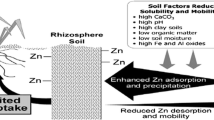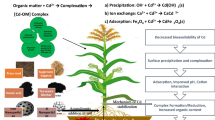Abstract
Background and aims
Increasing both yield and grain zinc (Zn) concentration (GZC) are the two important goals of maize production in China and elsewhere in the world. However, it is not clear whether soil application of Zn fertilizer could realize high yield and GZC. The current study aimed to examine how soil Zn application affects yield and GZC and what is the optimal DTPA-Zn for high yield and GZC requirement.
Methods
A 3-year field experiment with Zn fertilizer application rates of 0, 10, 25, 50, 100, 150 kg ZnSO4•7H2O ha−1 was conducted.
Results
Soil Zn application significantly increased soil DTPA-Zn concentrations, maize yield, GZC and kernels number per spike; and decreased the length of barren ear tips. In each of these cases, the level of response was highly related to the quantity of Zn added to soil. The optimal soil DTPA-Zn concentration was 4.7 mg kg−1 required to attain high yields and was 7.6 mg kg−1 required to attain high GZC, respectively.
Conclusion
Soil Zn fertilization can increase simultaneously both grain yield and GZC and achieved the biofortification of maize with Zn, and its realization depended on the available Zn concentrations in soil.



Similar content being viewed by others
References
Alloway BJ (2008) Zinc in soils and crop nutrition. In: Brussels: International Zinc Association, 2nd edn. International Fertilizer Industry Association, Paris
Alloway BJ (2009) Soil factors associated with zinc deficiency in crops and humans. Environ Geochem Hlth 31:537–548
Bender RR, Haegele JW, Ruffo ML, Below FE (2013) Nutrient uptake, partitioning, and remobilization in modern, transgenic insect-protected maize hybrids. Agron J 105:161
Broadley MR, White PJ, Hammond JP, Zelko I, Lux A (2007) Zinc in plants. New Phytol 173:677–702
Cakmak I (2008) Enrichment of cereal grains with zinc: agronomic or genetic biofortification? Plant Soil 302:1–17
Cakmak I (2012) Harvest Plus zinc fertilizer project: Harvest Zinc. Better Crops 96:17–19
Cerrato ME, Blackmer AM (1990) Comparison of models for describing corn yield response to nitrogen fertilizer. Agron J 82:138–143
Chaudhary DP, Kumar S, Langyan S (2014) Maize: nutrition dynamics and novel uses. Springer, India pp:65–95
Chen XP, Cui ZL, Fan MS, Vitousek P, Zhao M, Ma WQ, Wang ZL, Zhang WJ, Yan XY, Yang JC, Deng XP, Gao Q, Zhang Q, Guo SW, Ren J, Li SQ, Ye YL, Wang ZH, Huang JL, Tang QY, Sun YX, Peng XL, Zhang JW, He MR, Zhu YJ, Xue JQ, Wang GL, Wu L, An N, Wu LQ, Ma L, Zhang WF, Zhang FS (2014) Producing more grain with lower environmental costs. Nature 514:486–489
Fageria NK, Stone LF (2008) Micronutrient deficiency problems in South America. In: Alloway BJ (ed) Micronutrient deficiencies in global crop production. Springer, Netherlands, pp. 245–266
FAOSTAT (2014) Food and Agriculture Organization of the United Nations Statistics Division. Available from: http://faostat3.fao.org/browse/Q/QC/E
Grassini P, Eskridge KM, Cassman KG (2013) Distinguishing between yield advances and yield plateaus in historical crop production trends. Nat Commun 4(4):2918–2918
Kan CA, Meijer GAL (2007) The risk of contamination of food with toxic substances present in animal feed. Anim Feed Sci Technol 133:84–108
Karlen DL (1988) Aerial accumulation and partitioning of nutrients by corn. Agron J 80:232
Leff B, Ramankutty N, Foley JA (2004) Geographic distribution of major crops across the world. Global Biogeochem Cy 18:231–254
Lindsay WL, Norvell WA (1978) Development of a DTPA soil test for zinc, iron, manganese, and copper. Soil Sci Soc Amer J 42:421–428
Manzeke GM, Mtambanengwe F, Nezomba H, Mapfumo P (2014) Zinc fertilization influence on maize productivity and grain nutritional quality under integrated soil fertility management in Zimbabwe. Field Crop Res 166:128–136
Marschner P 2012 Marschner's mineral nutrition of higher plants. 3rd edn. Academic Press, pp 212–213
Martens DC, Westermann DT (1991) Fertilizer applications for correcting micronutrient deficiencies. Soil Sci Soc Am J 4:549–592
Meng QF, Hou P, Wu L, Chen XP, Cui ZL, Zhang FS (2013) Understanding production potentials and yield gaps in intensive maize production in China. Field Crop Res 143:91–97
Mengel K (1994) Iron availability in plant tissues-iron chlorosis on calcareous soils. Plant Soil 165:275–283
Mozafar A (1987) Interactions: nubbins (partially barren ears of maize [Zea mays L.]): a review of major causes including mineral nutrient deficiency. J Plant Nutr 10:1509–1521
Mueller ND, Gerber JS, Johnston M, Ray DK, Ramankutty N, Foley JA (2012) Closing yield gaps through nutrient and water management. Nature 490:254–257
Nuss ET, Tanumihardjo SA (2010) Maize: a paramount staple crop in the context of global nutrition. Compr Rev Food Sci F 9:417–436
Otegui ME, Bonhomme R (1998) Grain yield components in maize: I. Ear growth and kernel set. Field Crop Res 56:247–256
Potarzycki J (2010) The impact of fertilization systems on zinc management by grain maize. Fertilizers Fertilization 39:78–89
Rico MI, Alvarez JM, Mingot JI (1996) Efficiency of zinc ethylenediaminetetraacetate and zinc lignosulfonate soluble and coated fertilizers for maize in calcareous soil. J Agric Food Chem 44:3219–3223
Ritchie SW and Hanway JJ (1982) How a corn plant develops. Iowa State Univ of Sci and Tech, Coop Ext S. Special report No. 48
Sakal R, Singh AP, Singh BP (1981) Evaluation of critical limit of zinc in calcareous soils for predicting response of maize to applied zinc fertilizer. J Agric Sci 97:493–495
Saltzman A, Birol E, Bouis HE, Boy E, De Moura FF, Islam Y, Pfeiffer WH (2013) Biofortification: progress toward a more nourishing future. Glob Food Secur 2:9–17
Sangoi L (2001) Understanding plant density effects on maize growth and development: an important issue to maximize grain yield. Ciência Rural 31:159–168
Sharma PN, Chatterjee C, Agarwala SC, Sharma CP (1990) Zinc deficiency and pollen fertility in maize (Zea mays L.). Plant Soil 124:221–225
Singh B, Natesan S, Singh BK, Usha K (2005) Improving zinc efficiency of cereals under zinc deficiency. Curr Sci India 88:36–44
Ulrich A, Hills PJ (1967) Principles and practices of plant analysis. Soil Test Anal Part 11:11–24
Vaca R, Lugo J, Martinez R, Esteller MV, Zavaleta H (2011) Effects of sewage sludge and sewage sludge compost amendment on soil properties and Zea mays L. Plants (heavy metals, quality and productivity). Rev Int Contam Ambie 27:303–311
Wang JW, Mao H, Zhao HB, Huang DL, Wang ZH (2012) Different increases in maize and wheat grain zinc concentrations caused by soil and foliar applications of zinc in loess plateau, China. Field Crop Res 135:89–96
Wang ZM, Liu Q, Pan F, Yuan LX, Yin XB (2015) Effects of increasing rates of zinc fertilization on phytic acid and phytic acid/zinc molar ratio in zinc bio-fortified wheat. Field Crop Res 184:58–64
Xue YF, Zhang W, Liu DY, Yue SC, Cui ZL, Chen XP, Zou CQ (2014) Effects of nitrogen management on root morphology and zinc translocation from root to shoot of winter wheat in the field. Field Crop Res 161:38–45
Zare M, Khoshgoftarmanesh AH, Norouzi M, Schulin R (2009) Critical soil zinc deficiency concentration and tissue iron: zinc ratio as a diagnostic tool for prediction of zinc deficiency in corn. J Plant Nutr 32:1983–1993
Zelitch I (1982) The close relationship between net photosynthesis and crop yield. Biosci 32:796–802
Zhang YQ, Sun YX, Ye YL, Karim MR, Xue YF, Yan P, Meng QF, Cui ZL, Cakmak I, Zhang FS, Zou CQ (2012) Zinc biofortification of wheat through fertilizer applications in different locations of China. Field Crop Res 125:1–7
Zhao AQ, Lu XC, Chen ZH, Tian XH, Yang XW (2011) Zinc fertilization methods on zinc absorption and translocation in wheat. J Agric Sci 3:28
Zou CQ, Gao XP, Shi RL, Fan XY, Zhang FS (2008) Micronutrient deficiencies in crop production in China. In: Alloway BJ (ed) Micronutrient deficiencies in global crop production. Springer, Netherlands, pp. 127–148
Acknowledgments
This research was funded by grants from the 973 Project (2015CB150402), the National Science Foundation of China (31672240), the China Agriculture Research System (CARS-02), and the Innovative Group Grant of National Science Foundation of China (31421092). We acknowledge Dr. Bruce Jaffee in USA for proof reading of manuscript and Prof. Mike McLaughlin for revising the manuscript.
Author information
Authors and Affiliations
Corresponding author
Additional information
Responsible Editor: Mike McLaughlin.
Rights and permissions
About this article
Cite this article
Liu, DY., Zhang, W., Yan, P. et al. Soil application of zinc fertilizer could achieve high yield and high grain zinc concentration in maize. Plant Soil 411, 47–55 (2017). https://doi.org/10.1007/s11104-016-3105-9
Received:
Accepted:
Published:
Issue Date:
DOI: https://doi.org/10.1007/s11104-016-3105-9




